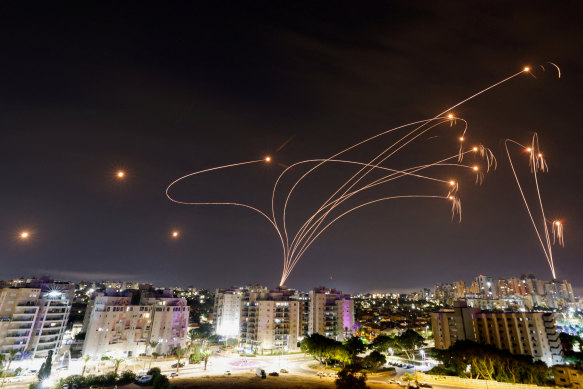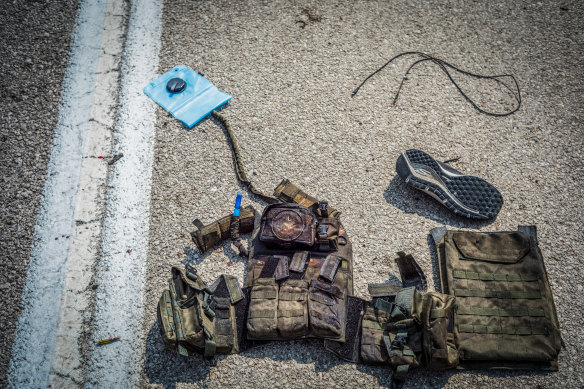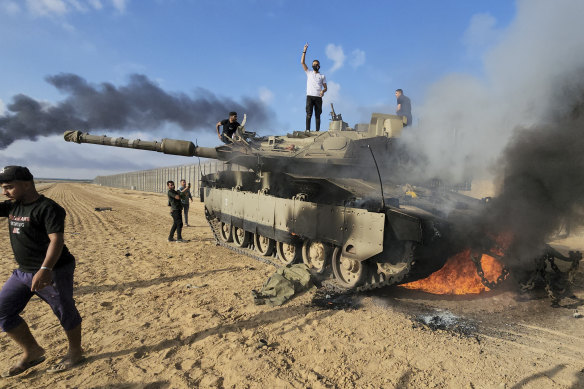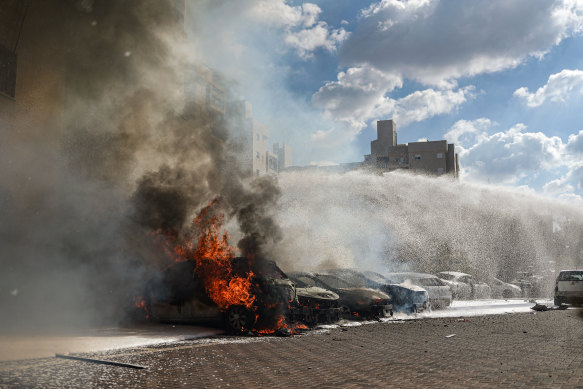
Israel has sophisticated defence networks that include one of the world’s strongest militaries and a renowned intelligence service. How did Hamas breach them?
Save articles for later
Add articles to your saved list and come back to them any time.
Unannounced and unanticipated, the first wave of gunmen slipped into Israel at dawn, preceded by the first of thousands of unguided “Qassam” rockets zipping overhead. Once on Israeli soil, they infiltrated nearby towns, security installations and a remote outdoor music festival, killing civilians and security forces indiscriminately and snatching some 150 hostages. Shocking footage emerged of festival-goers crouching in terror under bushes, rows of abandoned and burnt-out cars and of a young woman begging for her life, jammed between two militants on a speeding motorcycle.
As Israeli forces flooded the area to root out the remaining insurgents, the October 7 attack – orchestrated by the Islamist organisation known as Hamas – was being characterised as the greatest challenge to Israel’s security since the Yom Kippur War which, not coincidentally, began almost 50 years ago.
“They got us,” said Major Nir Dinar, spokesperson for the Israeli Defence Forces, as Reuters reported. Israel, a nation confident in its military capabilities, with a famed intelligence network, contemporary weaponry and compulsory national service, had been outplayed, at least temporarily.
Israel’s Iron Dome intercepts rockets from the Gaza Strip on October 9.Credit: Reuters
Israel’s sophisticated Iron Dome anti-ballistic missile system performed as expected, but still allowed some of the low-tech projectiles through; its much-vaunted “iron wall” security barrier, cordoning off Gaza, proved surprisingly vulnerable to low-tech force and guile; and, while its highly trained army engaged with the insurgents, some 900 lives, both civilians and soldiers, were lost in the raids.
Israel has subsequently pledged to “wipe out” Hamas, conducted dozens of airstrikes within the Gaza Strip, called up its reservists and, say defence analysts, is all but committed to a gruelling ground war. It has also sealed off the enclave from food, fuel and other supplies.
As the conflict threatens to spread to Lebanon on Israel’s northern border, where there have been exchanges of fire, difficult questions linger for the grieving nation. Chiefly, how were Israel’s supposedly impenetrable defences overwhelmed?
Where did the militants attack from?
The Hamas gunmen emerged from the Gaza Strip, the smaller of the two major Palestinian-populated territories that bookend Israel (the other being the West Bank). A sleeve of land on the Mediterranean coast, it’s just 41 kilometres long and varies in width from six to 12 kilometres, in total, about the size of the US city of Detroit.
Gaza has a complicated and contested history; since the beginning of last century the territory has been in the hands of the Ottoman Empire, Britain, Egypt and Israel. Home to more than 2 million Palestinians, it is one of the world’s most densely populated regions. It is also one of the most deprived: these days it is all but cut off from the outside world and dependent on Israel for much, if not all, of its access to food, water and energy.
About 81 per cent of the population lives in poverty and the unemployment rate is nearly half, says the United Nations Relief and Works Agency for Palestine Refugees, which provides services for refugees in Gaza. Around 1 million people rely on daily food aid.
There are eight official refugee camps within Gaza that together accommodate more than 600,000 people. Some of the camps were set up to house Palestinian families fleeing the Arab-Israeli War in 1948, when Israel was first declared a state.
Israel captured the Gaza Strip from Egypt during the Six Day War in 1967 and directly controlled the territory for more than three decades. In 2005, Israeli security forces, and settlers, pulled out of Gaza but Israel continues to control the territory’s airspace and shoreline and restricts the movement of people and goods. Egypt also tightly controls its border. The Gaza Strip has been administered solely by the Islamist group Hamas since 2007.
What is Hamas and what is its role in Gaza?
Hamas, an acronym for Harakat al-Muqawama al-Islamiya (Islamic Resistance Movement), has been the de facto authority in Gaza since shortly after Israel withdrew from the territory in 2005. Hamas defeated a more moderate party, Fatah, in elections in 2006 and, by 2007, had expelled its rivals and taken complete control. Fatah controls the Palestinian National Authority in the West Bank.
Hamas does not recognise Israel but has committed to the formation of a Palestinian state within the “1967 borders”, which refer to those existing before that year’s war in which Israel occupied East Jerusalem, the West Bank (the Palestinian territory on the west bank of the River Jordan, to Israel’s east) and the Gaza Strip.
The gear of a Palestinian fighter on a road in the aftermath of a deadly attack on a police station in the Israeli city of Sderot on October 8.Credit: Getty Images
Founded in 1987 by Palestinian cleric Sheikh Ahmed Yassin, Hamas has a military wing committed to armed struggle against Israel. The organisation has used its dominance of the Gaza Strip to launch intermittent ground and air attacks across the border into Israel.
The group is deemed a terrorist organisation by many countries including the United States, the European Union and Australia. Iran, a staunch adversary of Israel, is a known backer of Hamas and is accused of providing it with funds, weapons and training. The Lebanon-based militant group Hezbollah also poses a threat to Israel on its northern border and has reportedly been involved in piecemeal skirmishes in recent days.
During an 11-day clash in May 2021, Hamas and another militant group, Palestinian Islamic Jihad, fired more than 4000 rockets from Gaza, killing 10 Israeli civilians and injuring more than 300 others. Israeli air strikes during the conflict killed more than 200 Palestinian civilians and caused damage worth hundreds of millions of dollars to infrastructure and buildings.
How did Hamas militants breach Israeli defences?
In 2021, Israel unveiled a newly fortified 65-kilometre barrier along its boundary with the Gaza Strip, the latest “upgrade” to a fence that had existed since at least 1994. Made of 140,000 tonnes of iron and steel and topped with razor wire, it reaches six metres high, is designed to foil tunnelling underground and bristles with detection systems including cameras and radar.
Palestinians stand on a destroyed Israeli tank at the Gaza Strip fence on October 7.Credit: AP
Hamas got through it. Well-placed sources told Reuters the Hamas equivalent of commandos secured the incursion points in the barricade, which were then blown open with explosives or pushed over with bulldozers or tractors. The IDF said the barricade was breached in 29 places, reported The Washington Post. Another Hamas unit, say the Reuters sources, attacked the Israeli Army’s southern Gaza headquarters and jammed its communications. Some gunmen managed to evade Israel’s maritime cordon in speedboats. Militants also headed for the Supernova music festival, about five kilometres inside Israel from the Gaza Strip, murdering some 260 people, according to the BBC, and taking hostages.
In all, according to US Secretary of State Antony Blinken, around 1000 attackers took part in the various raids.
Earlier, waves of unguided Qassam rockets, named for the military wing of Hamas, and hoarded by the group in their thousands, streamed overhead from the Gaza Strip into Israel. Some managed to penetrate the Iron Dome defence system but analysts we spoke with generally agreed their main purpose was to distract security forces while the gunmen carried out their terror attack on the ground.
Horrific images of alleged Hamas brutality have since flooded social media. “I’ve probably geolocated 20-plus individual atrocities committed by Hamas in Israel, incredibly personal acts committed by the perpetrators,” writes OSINTtechnical, a micro-blogger on open-source intelligence, on X (formerly Twitter).
Hamas “scrupulously studied the patterns of behaviour of the Israeli defence force and the security apparatus in and around the Gaza Strip,” according to former army officer John Blaxland, now Professor of International Security and Intelligence Studies at ANU, based out of Washington DC.
“They’ve sacrificed people on the way to test and evaluate and figure out where the vulnerabilities lay, they’ve kept their powder dry and then they’ve thrown everything at it.”
The timing of the assault, on the Sabbath and at the end of the seven-day Sukkot holiday, could have been a useful factor for the insurgents too, says Dr Eyal Mayroz, a former counterterrorism analyst in Israel’s defence forces now with the University of Sydney’s Department of Peace and Conflict Studies.
Says Ian Parmeter, research scholar at the Centre for Arab and Islamic Studies at ANU: “It’s a time when a lot of people are taking holidays and there appear to have been a lot of servicemen and women on holiday because of the long break who obviously wanted to go and spend time with their families.”
What exactly is the Iron Dome and did it work?
As rockets careen into Israel, a system of ground-based radars and missiles known as the Iron Dome detects the attacks and decides whether or not to intercept them, since many of the crude Hamas projectiles are ineffective. The system has been operational since 2011 and can down rockets or mortars originating from between four and 70 kilometres away (roughly the distance from Gaza to Tel Aviv).
The Iron Dome consists of 10 ground systems, called batteries, which the IDF can move around according to need. Each system consists of three to four launchers holding 20 missiles, according to US defence contractor Raytheon. The US reportedly contributed $US1.6 billion to the Iron Dome between 2011 and 2021.
The missiles cost between $20,000 and $50,000, says Michael Shoebridge, director of Strategic Analysis Australia. “They’re orders of magnitude cheaper than a lot of European and American missiles,” he says. “They knew they needed to be able to make and use them at volume.” If deployed, sensors adjust the missiles’ course so they explode near the attacking projectile and destroy it.
Analysts say the Iron Dome has worked as it should since Saturday’s conflict. Israeli company Rafael Advanced Defense Systems says the system has a 90 per cent interception rate, which means if it is tackling many hundreds of targets simultaneously some may get through. In the initial attacks, “Israel say there were 2500 rockets fired, Hamas say they fired 5000, so it’s probably somewhere in the middle,” says Martin Kear, from the department of government and international relations at the University of Sydney. “[The Iron Dome] was the only system that worked. It shot down or intercepted the majority of those rockets.”
One sign of the system’s effectiveness is that damage from rockets in Israel appears limited, says Shoebridge. “Hamas judged that Israeli air defence was very effective,” he says. “It forced the terrorists to innovate and do something different, which they have done with murderous effect.”
The Iron Dome isn’t Israel’s only air defence system: a medium- to long-range system called David’s Sling can intercept missiles fired from 40 to 300 kilometres away. Still, the systems are not impenetrable. “A layered air defence system is still going to struggle with a very high volume of incoming missiles or rockets,” Shoebridge says. “[But] they have prepared for those scenarios. And the thing about Hezbollah and Hamas rocket and missile stocks is they’re not inexhaustible.”
A blaze following a rocket attack from Gaza in Ashkelon on October 7.Credit: Getty Images
Should Israel’s intelligence services have seen this coming?
The prevailing view among analysts is that Hamas successfully managed to convince Israeli observers it had no appetite for a major conflict. Says Martin Kear: “A lot of people will certainly be fired, I think at the end of the day, publicly or privately, because there’s been some significant intelligence failures.”
Israeli left-wing newspaper Haaretz revealed that an assessment by security services as recently as last week found that Hamas wanted “to avoid a full-fledged war with Israel”. Associated Press has subsequently quoted an unnamed Egyptian intelligence official saying Egypt had spoken repeatedly with Israel about “something big” brewing. “They underestimated such warnings,” said the official, according to AP.
Says Mayroz: “The premise was that Hamas was not interested in escalation because of a number of reasons but mostly the risk to themselves, to their leaders, to their operatives as well as to welfare of the Gazan population.” This, apparently, became the prevailing view in Israel’s security apparatus. “And even though I’m not privy to that firsthand intelligence, based on what I could read, that was my impression as well.”
Yet, as it turned out, Hamas had been preparing for this attack for, according to reports, months if not years: planning, scrutinising Israeli defences, hoarding weaponry and training, reportedly orchestrated by the shadowy commander Mohammed Deif. “So little is known about him that even his name is a mystery,” writes Mehul Srivastava in the Financial Times. Deif means “guest”; his real name is supposedly Mohammed Diab Ibrahim al-Masri. “People who knew him in the 1980s say that even then he went by the name Deif, while others said they knew him by his birth name. Only one grainy photograph of him exists in the public domain.”
Deif is believed to have made a prepared statement explaining the motivation for the attack, according to The New York Times, where he cited Israel’s occupation of the West Bank, recent Israeli police raids on the Al Aqsa Mosque in Jerusalem, and the detention of thousands of Palestinians in Israeli jails. “In many ways,” says Parmeter, “one can see what Hamas has just done has been to try to get the Palestinian situation back on the international agenda, because Israel has been doing its best, from their perspective, to take it off.”
‘The Israeli intelligence failed badly and just simply didn’t spot it. It was a complete surprise.’
While Israel has built up a sophisticated intelligence network, says Blaxland, as its methods became known Hamas was able to adopt counter-measures and hoodwink the Israelis into thinking the 50th anniversary of the Yom Kippur War, when Syria and Egypt launched a surprise attack on Israel in 1973, would be a “non-event”.
How? By years of trial and error, he says. “They’ve burned a lot of people along the way, a lot of people have been caught by Israeli intelligence, but each increment has taught Hamas a lesson. And they’re now at the stage where they’re one step ahead of the Israelis.”
Most analysts we contacted agreed Israel could have been better prepared and that its spooks, agencies such as the Mossad, Shin Bet and military intelligence, stumbled. “This was a basic intelligence failure on the part of the Israelis and I think there’ll be a lot of questions asked about just how they failed so badly,” says Dr Malcolm Davies, a senior analyst at the Australian Strategic Policy Institute.
“This operation was so sophisticated that it would have, essentially, taken quite a bit of time to plan it, to prepare for and train for it. There’s increasing suspicion now that the Iranians were directly involved in this operation. But certainly, the Israeli intelligence failed badly and just simply didn’t spot it. It was a complete surprise.”
Get fascinating insights and explanations on the world’s most perplexing topics. Sign up for our weekly Explainer newsletter.
If you'd like some expert background on an issue or a news event, drop us a line at [email protected] or [email protected]. Read more explainers here.
Most Viewed in World
Source: Read Full Article



